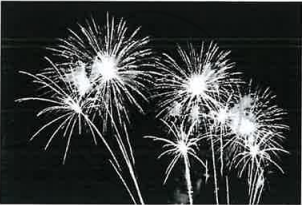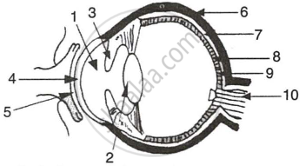Advertisements
Advertisements
Question
Give scientific reason:
One can sense colours only in bright light.
Solution
- The light sensitive screen of the eye, called the retina, has two types of light sensitive cells.
- Rod cells are concerned with vision in dim light and cone cells are responsible for the vision in presence of light.
- Cone cells are also concerned with colour perception. They do not respond to dim light or no light.
- Thus, the knowledge of the colour is possible in presence of light and not in dark.
- Hence, we can identify and differentiate colours in presence of light.
RELATED QUESTIONS
List the parts of the human eye that control the amount of light entering into it. Explain how they perform this function.
Write the function of retina in human eye.
Draw labelled diagrams of the following: Eye
Differentiate between: Rods and cones
Myopia is an example of ______.
Night birds have ______ cones than rods in their eyes.
Draw a labelled sketch of the human eye.
Describe the anatomy of the human eye.
Where is the image formed in a human eye?
Name two types of cells in the retina of an eye which respond to light.
Fill in the following blank with suitable word:
The iris controls the amount of................entering the eye.
What changes take place in the shape of eye-lens:
when the eye is focused on a near object?
How does the convex eye-lens differ from the ordinary convex lens made of glass?
Why does the eye-lens not have to do all the work of converging incoming light rays?
State whether the following statement is true or false:
Rabbit has eyes which look sideways.
Fill in the following blank with suitable word:
Having two eyes gives a ................field of view.
Name two animals having eyes:
one the sides of the head.
Name two animals having eyes:
at the front of the head.
Among animals, the predators (like lions) have their eyes facing forward at the front of their heads, whereas the animals of prey (like rabbit) usually have eyes at the sides of their head. Why is this so?
Differentiate between members of the following pair with reference to what is asked in bracket.
Rod and cone cells (pigment contained)
Given below is a set of five parts. Rewrite them in correct sequence.
Conjunctiva, retina, cornea, optic nerve, lens.
With reference to the functioning of the eye, answer the question that follow:
Name the cells of the retina and its respective pigments which get activated in the light.
Define the following:
Power of accommodation
State the Function:
Iris
Choose the Odd One Out:
Complete the following sentence with appropriate Word
The photoreceptor cells of the retina sensitive to colour are:
The image of an object at an infinite distance is obtained in a real and erect form through a convex magnifying glass.
For a healthy human eye, the distant point is infinite distance.
Write an Explanation.
Farthest distance of distinct vision
Complete the paragraph by choosing the right options given below.
(minimum, near point, 25 cm, farthest, farthest distance, far point)
The _______ distance of an object from a normal eye, at which it is clearly visible without stress on the eye, is called the minimum distance of distinct vision. The position of the object at this distance is called the _______ of the eye, for a normal human eye, the near point is at _______. The _______ distance of an object from a human eye, at which it is clearly visible without stress on the eye is called _______ of distinct vision. The position of the object at this distance is called the _______ of the eye.
When light rays enter the eye, most of the refraction occurs at the ____________.
______ is a transparent layer.
______ of the eye is comparable to the film of a camera.
Describe the parts in the external structure of the eye.
Chris was watching the display of fireworks in the sky.

- Trace the path of the light rays using the following terms:
Fovea, Lens, Conjunctiva, Pupil, Cornea. - Name the nerve that carries the impulse for vision to the brain.
State the functions of the following:
Iris
The figure given below refers to the vertical section of the eye of a mammal. Study the figure carefully and answer the following questions.
 |
- Label the guidelines shown as 1 to 10.
- Write one important role of parts shown as 3 and 7.
- Write one structural difference between the parts shown as 9 and 10.
- Mention one functional difference between the parts shown as 6 and 8.
